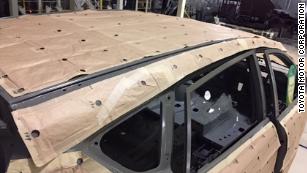In the nearly four years since Microsoft introduced its HoloLens augmented-reality headset, consumers have largely forgotten about it. But now it's gaining traction among an unlikely audience: car makers.
Toyota is one of a growing number of auto makers hoping augmented-reality headsets can improve everything from designing cars to manufacturing and fixing them. These headsets let users merge 3-D images with the real world.
For example, Ford and heavy-duty truck maker Paccar are among those using the HoloLens tohelp design cars, and Daimler recently said it purchased over 100 HoloLens headsets to train its mechanics with 3-D models of vehicles and parts like brake systems.
But the augmented-reality market is still small: Eric Abbruzzese, an augmented- and virtual-reality analyst with ABI Research, expects more than 2 million headsets and smart glasses will ship this year. Most of that market is made up of businesses still testing the technology. Abbruzzese predicts it will grow to 29 million by 2023.
The most recent example of car makers adopting the technology is Toyota. At its headquarters in Japan's Aichi prefecture, employees like Koichi Kayano are experimenting with HoloLens for a variety of tasks. Kayano, a project manager who finds ways to use 3-D models across the company, is using the headset to speed up the process of measuring the thickness of a vehicle's paint and rust-prevention coatings to ensure consistent color and avoid corrosion.
Typically, this process takes two people an entire day, but the HoloLens cuts it down to four hours -- and only requires one person to do it. Workers traditionally carefully place specially-made paper patterns, which have about 500 holes cut throughout, on the exterior of a car. An employee then scans the visible paint with a measuring instrument.
Now, Kayano and his team developed an app that lets them skip the paper pattern and use the HoloLens to project a digital array of dots onto a real car, revealing which areas need to be tested.
"It's as quick as wearing a HoloLens and seeing the measurement points virtually on the vehicle," Kayano told CNN Business through an interpreter during a phone interview. "Preparation time is, like, instant."
Toyota is also using the headset to visualize new machines on the factory floor, at scale and in 3-D, and determine where they will fit. It's also conducting a similar experiment to figure out whether large vehicles can fit inside a building.
But HoloLens still faces adoption challenges. To start, HoloLens is a pricey investment -- it costs $3,000 or $5,000 per headset, depending on whether you want a developer or enterprise version. The hardware also hasn't been updated since it was released two and a half years ago, and at 1.3 pounds, it remains heavy, especially when worn for hours at a time. Meanwhile, the battery only lasts between two and three hours of continuous use.
HoloLens is far from the only wearable AR device on the market. It competes with Magic Leap's recently released Magic Leap One headset and AR glasses from companies such as ODG, Vuzixand Epson. Still, HoloLens has become the "gold standard" of high-end AR products due to features like showing the user 3-D images that can stick to one spot in the real world and letting a remote person see what's in the user's real-world field of view, said Abbruzzese.
However, companies have been somewhat slow to buy and use AR technology due to concerns about cost as well as if it's worth it to provide the resources to train workers.
But Abbruzzese said Toyota's use of the HoloLens to measure paint thickness is a clear example of possible savings.
"Toyota can then make a very informed decision about how well this can scale, and [determine] the return on investment," he said.
Toyota declined to share how many headsets the company has bought so far. But Microsoft did confirm the car companies are purchasing them -- either from Microsoft itself or from a supplier.
Although Toyota's HoloLens project is only a test so far, the company said it's also helping with the development of a vehicle coming to the market in the near future.


